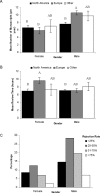Systematic variation in reviewer practice according to country and gender in the field of ecology and evolution
- PMID: 18787653
- PMCID: PMC2527679
- DOI: 10.1371/journal.pone.0003202
Systematic variation in reviewer practice according to country and gender in the field of ecology and evolution
Abstract
The characteristics of referees and the potential subsequent effects on the peer-review process are an important consideration for science since the integrity of the system depends on the appropriate evaluation of merit. In 2006, we conducted an online survey of 1334 ecologists and evolutionary biologists pertaining to the review process. Respondents were from Europe, North America and other regions of the world, with the majority from English first language countries. Women comprised a third of all respondents, consistent with their representation in the scientific academic community. Among respondents we found no correlation between the time typically taken over a review and the reported average rejection rate. On average, Europeans took longer over reviewing a manuscript than North Americans, and females took longer than males, but reviewed fewer manuscripts. Males recommended rejection of manuscripts more frequently than females, regardless of region. Hence, editors and potential authors should consider alternative sets of criteria, to what exists now, when selecting a panel of referees to potentially balance different tendencies by gender or region.
Conflict of interest statement
Figures


Similar articles
-
With great power comes great responsibility: the importance of rejection, power, and editors in the practice of scientific publishing.PLoS One. 2013 Dec 30;8(12):e85382. doi: 10.1371/journal.pone.0085382. eCollection 2013. PLoS One. 2013. PMID: 24386471 Free PMC article.
-
[The recognition of peer reviewers activity: the potential promotion of a virtuous circle.].Recenti Prog Med. 2017 Sep;108(9):355-359. doi: 10.1701/2745.27985. Recenti Prog Med. 2017. PMID: 28901342 Italian.
-
The Game Between a Biased Reviewer and His Editor.Sci Eng Ethics. 2019 Feb;25(1):265-283. doi: 10.1007/s11948-017-9998-8. Epub 2017 Oct 27. Sci Eng Ethics. 2019. PMID: 29079911
-
A Learned Society's Perspective on Publishing.J Neurochem. 2016 Oct;139 Suppl 2:17-23. doi: 10.1111/jnc.13674. Epub 2016 Aug 17. J Neurochem. 2016. PMID: 27534728 Review.
-
Reviewing scientific manuscripts: how much statistical knowledge should a reviewer really know?Adv Physiol Educ. 2009 Mar;33(1):7-9. doi: 10.1152/advan.90207.2008. Adv Physiol Educ. 2009. PMID: 19261753 Review.
Cited by
-
A stronger post-publication culture is needed for better science.PLoS Med. 2014 Dec 30;11(12):e1001772. doi: 10.1371/journal.pmed.1001772. eCollection 2014 Dec. PLoS Med. 2014. PMID: 25548904 Free PMC article.
-
Ensuring the Quality, Fairness, and Integrity of Journal Peer Review: A Possible Role of Editors.Sci Eng Ethics. 2016 Feb;22(1):169-88. doi: 10.1007/s11948-015-9625-5. Epub 2015 Jan 30. Sci Eng Ethics. 2016. PMID: 25633924
-
With great power comes great responsibility: the importance of rejection, power, and editors in the practice of scientific publishing.PLoS One. 2013 Dec 30;8(12):e85382. doi: 10.1371/journal.pone.0085382. eCollection 2013. PLoS One. 2013. PMID: 24386471 Free PMC article.
-
Does publication in top-tier journals affect reviewer behavior?PLoS One. 2009 Jul 21;4(7):e6283. doi: 10.1371/journal.pone.0006283. PLoS One. 2009. PMID: 19621085 Free PMC article.
References
-
- Kliewer MA, DeLong DM, Freed K, Jenkins CB, Paulson EK, et al. Peer review at the American Journal of Roentgenology: How reviewer and manuscript characteristics affected editorial decisions on 196 major papers. Am J Roentgenol. 2004;183:1545–1550. - PubMed
-
- Lortie CJ, Aarssen LW, Budden AE, Koricheva JK, Leimu R, et al. Publication bias and merit in ecology. Oikos. 2007;116:1247–1253.
-
- Weller A. Editorial Peer Review: Its Strengths and Weaknesses. New Jersey: Information Today Inc; 2001.
-
- Kliewer MA, Freed KS, DeLong DM, Pickhardt PJ, Provenzale JM. Reviewing the reviewers: comparison of review quality and reviewer characteristics at the American Journal of Roentgenology. Am J Roentgenol. 2005;184:1731–1735. - PubMed
-
- Millett D. Training the Reviewer? J Orthod. 2006;33:1–2. - PubMed
Publication types
MeSH terms
LinkOut - more resources
Full Text Sources

